By Nate Zitnik
Offensive Coordinator
Otto-Eldred High School (PA)
Twitter: @nzshuttlesworth
“Only three things can happen when you pass the football, and two of them are bad!”
You can make any excuse you want to not throw the football but, in the end, that’s all it is - an excuse. The game of football is changing and evolving. Regardless of where you coach, what level you coach, or what offense you run; the pass game is something that needs to be integrated into your repertoire. With that being said… How do you do that? And more so… how do you do that easily and effectively?
The Triangle Concept provides a framework for your pass game and can be adapted to defeat pressure using the running back (F) in a rush progression.
“Our quarterback can’t throw the ball 20 yards and couldn’t hit water if he fell from a boat!”
Most of the throws in the Triangle Concepts are short to intermediate high percentage throws. However, these throws need to be practiced and more importantly practiced within the circumstances of the progression.
“We’ve got kids that couldn’t pour water out of a boot with instructions on the heel.”
Drilling these throws and following a drill progression is paramount to the success of these concepts. Athletes, especially quarterbacks, appear incapable often because they don’t understand the reads and progressions of the plays they’ve been asked to execute. With, efficient and meaningful drills scaffolded within consistent practice plans over the course of the season can turn even the most improbable player into a functional and effective passing threat.
Spacing Concept
The Spacing Concept uses fast-developing routes of three or four receivers versus two or three defenders respectively. This in conjunction with short/intermediate high percentage throws makes the Spacing Concept an ideal pass play for any offense.
There are variations to this play, but the triangle of the concept remains constant. The Spacing Concept to the three-receiver side is favorable for any team that Inserts some sort of zone coverage to the Trips formation. The receivers and the back releasing to the concept side create both a horizontal and vertical stretch of the defense.
The horizontal stretch of the defense is achieved with the back (F) swinging out to the numbers and the middle receiver (Y) receiver running a six back to five-yard snag route. The flat defender is then faced with the decision of running inside with the snag route by the Y receiver or taking an outside angle towards the numbers to intercept the F out of the backfield.
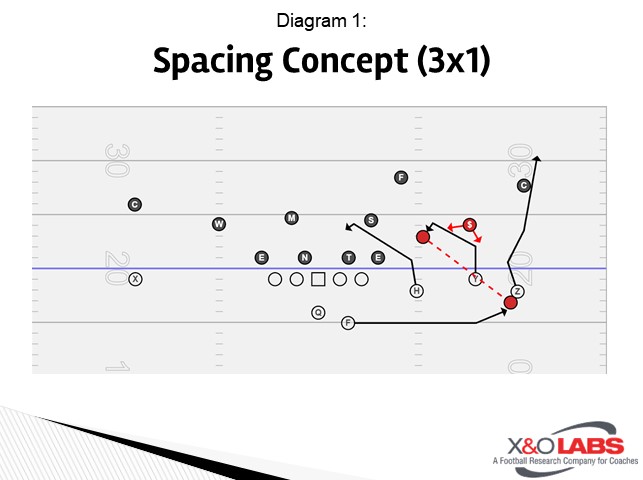
The vertical stretch of the defense is accomplished by the outermost (Z) receiver running a fade route. The fade route will prevent the defenders playing over top of the hard deck (approximately 7 yds from the LOS) from attacking that downhill space being attacked by the snag and swing routes. This completes the triangle and illustrates the three-receiver vs the two-defender read concept.
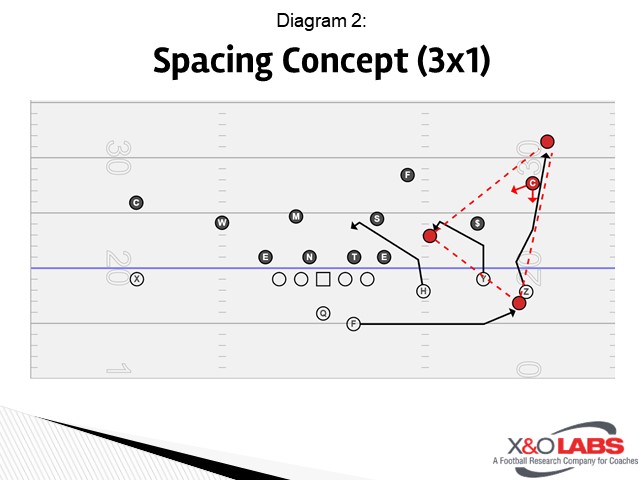
The final aspect of the routes within the Spacing Concept is the inside receiver (H) in the Trips formation running a six to five-yard snag route as well. This route takes advantage of the inside linebacker (S) attacking the snag, following the back (F) out of the backfield, or bringing pressure. Because the back (F) must be a free release player in this concept, you must employ a five-man protection. I prefer and use a half slide/half man protection. The zone side is always called away from the concept. The left tackle, guard, and center (Blue) must account for the three backside defenders (Also Blue). The man side is to the concept. The right guard and right tackle (Green) must account for the nose and defensive end (Also Green). The sixth defender (S) must be accounted for by the quarterback.
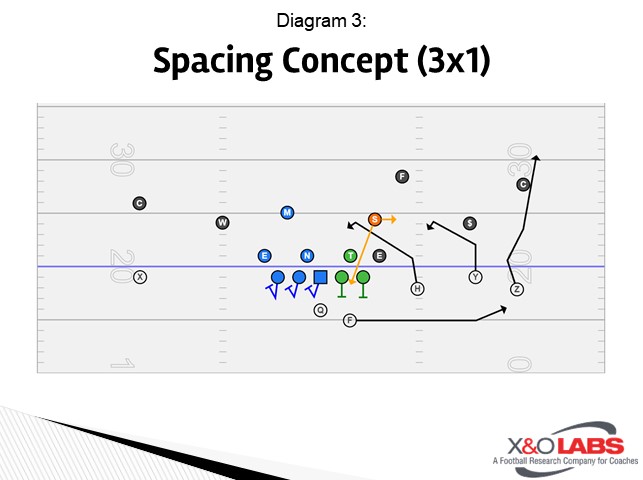
The progression of the routes is (Hot vs Rush) Y Snag, to F Swing, to Z Go. The backside single (X) receiver can be given essentially any route. The route should effectively attack the most anticipated coverage of your opponent, be something your receiver runs well and is an everyday throw for the quarterback. A PSR man beating option route is ideal if it fits within the framework of your offense.
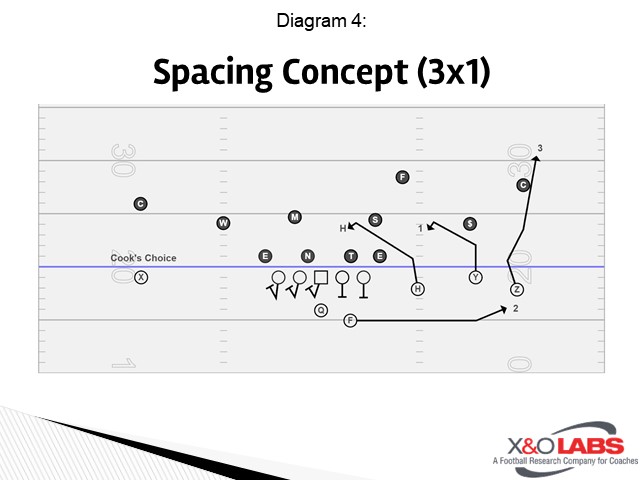
Overall Coaching Points:
The free release/concept side should coincide with the man side of the pass protection as it protects the quarterback’s blindside and provides a built-in rush progression.
Aside from the ability to include the F in the triangle with a free release, it also incentivizes the quarterback to take an interest and ownership in protections.
Trust the process. Do not allow players to force or lobby for the ball. The defense dictates the quarterback's decision as to where to deliver the football.
Spacing Concept Drill Work:
There is no return without investment. The Triangle Concept requires a significant amount of time to install and consistent practice repetitions over the course of the season. Drilling each aspect of the concept is a non-negotiable. Start separately at first and progress as your quarterbacks and receivers become comfortable within the concept regardless of the defensive scheme or progression. The progressions listed on the slides provide a starting point for the drills. Creating a rush progression to utilize in certain situations or as the defense adjusts will develop consistency and confidence in the reads.
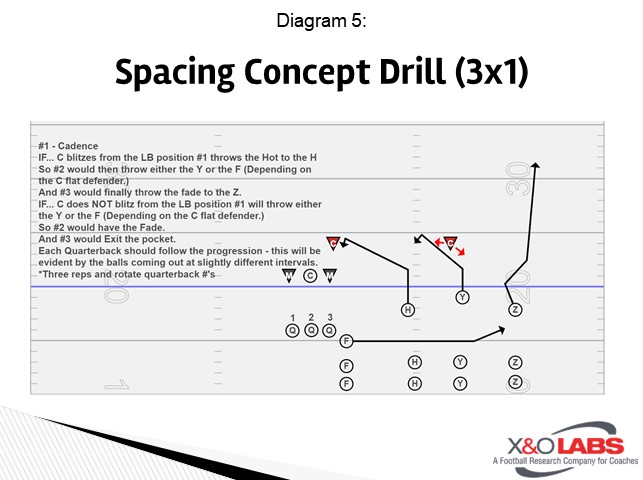
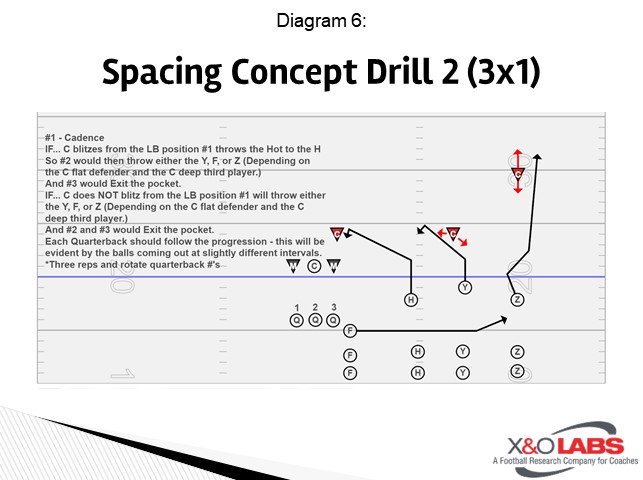
QB Coaching Points:
This is a
Offensive Coordinator
Otto-Eldred High School (PA)
Twitter: @nzshuttlesworth
“Only three things can happen when you pass the football, and two of them are bad!”
You can make any excuse you want to not throw the football but, in the end, that’s all it is - an excuse. The game of football is changing and evolving. Regardless of where you coach, what level you coach, or what offense you run; the pass game is something that needs to be integrated into your repertoire. With that being said… How do you do that? And more so… how do you do that easily and effectively?
The Triangle Concept provides a framework for your pass game and can be adapted to defeat pressure using the running back (F) in a rush progression.
“Our quarterback can’t throw the ball 20 yards and couldn’t hit water if he fell from a boat!”
Most of the throws in the Triangle Concepts are short to intermediate high percentage throws. However, these throws need to be practiced and more importantly practiced within the circumstances of the progression.
“We’ve got kids that couldn’t pour water out of a boot with instructions on the heel.”
Drilling these throws and following a drill progression is paramount to the success of these concepts. Athletes, especially quarterbacks, appear incapable often because they don’t understand the reads and progressions of the plays they’ve been asked to execute. With, efficient and meaningful drills scaffolded within consistent practice plans over the course of the season can turn even the most improbable player into a functional and effective passing threat.
Spacing Concept
The Spacing Concept uses fast-developing routes of three or four receivers versus two or three defenders respectively. This in conjunction with short/intermediate high percentage throws makes the Spacing Concept an ideal pass play for any offense.
There are variations to this play, but the triangle of the concept remains constant. The Spacing Concept to the three-receiver side is favorable for any team that Inserts some sort of zone coverage to the Trips formation. The receivers and the back releasing to the concept side create both a horizontal and vertical stretch of the defense.
The horizontal stretch of the defense is achieved with the back (F) swinging out to the numbers and the middle receiver (Y) receiver running a six back to five-yard snag route. The flat defender is then faced with the decision of running inside with the snag route by the Y receiver or taking an outside angle towards the numbers to intercept the F out of the backfield.

The vertical stretch of the defense is accomplished by the outermost (Z) receiver running a fade route. The fade route will prevent the defenders playing over top of the hard deck (approximately 7 yds from the LOS) from attacking that downhill space being attacked by the snag and swing routes. This completes the triangle and illustrates the three-receiver vs the two-defender read concept.

The final aspect of the routes within the Spacing Concept is the inside receiver (H) in the Trips formation running a six to five-yard snag route as well. This route takes advantage of the inside linebacker (S) attacking the snag, following the back (F) out of the backfield, or bringing pressure. Because the back (F) must be a free release player in this concept, you must employ a five-man protection. I prefer and use a half slide/half man protection. The zone side is always called away from the concept. The left tackle, guard, and center (Blue) must account for the three backside defenders (Also Blue). The man side is to the concept. The right guard and right tackle (Green) must account for the nose and defensive end (Also Green). The sixth defender (S) must be accounted for by the quarterback.

The progression of the routes is (Hot vs Rush) Y Snag, to F Swing, to Z Go. The backside single (X) receiver can be given essentially any route. The route should effectively attack the most anticipated coverage of your opponent, be something your receiver runs well and is an everyday throw for the quarterback. A PSR man beating option route is ideal if it fits within the framework of your offense.

Overall Coaching Points:
The free release/concept side should coincide with the man side of the pass protection as it protects the quarterback’s blindside and provides a built-in rush progression.
Aside from the ability to include the F in the triangle with a free release, it also incentivizes the quarterback to take an interest and ownership in protections.
Trust the process. Do not allow players to force or lobby for the ball. The defense dictates the quarterback's decision as to where to deliver the football.
Spacing Concept Drill Work:
There is no return without investment. The Triangle Concept requires a significant amount of time to install and consistent practice repetitions over the course of the season. Drilling each aspect of the concept is a non-negotiable. Start separately at first and progress as your quarterbacks and receivers become comfortable within the concept regardless of the defensive scheme or progression. The progressions listed on the slides provide a starting point for the drills. Creating a rush progression to utilize in certain situations or as the defense adjusts will develop consistency and confidence in the reads.


QB Coaching Points:
This is a








